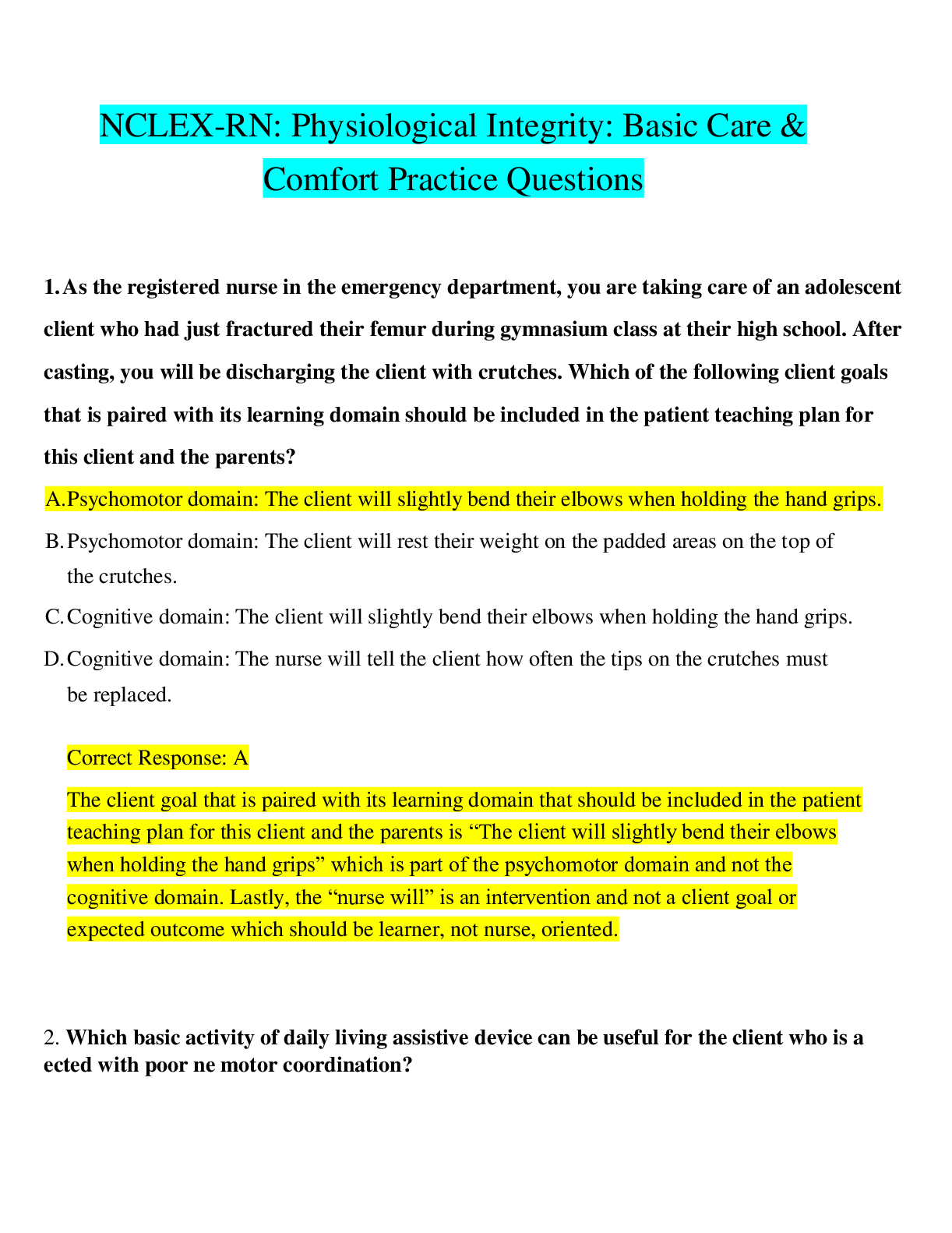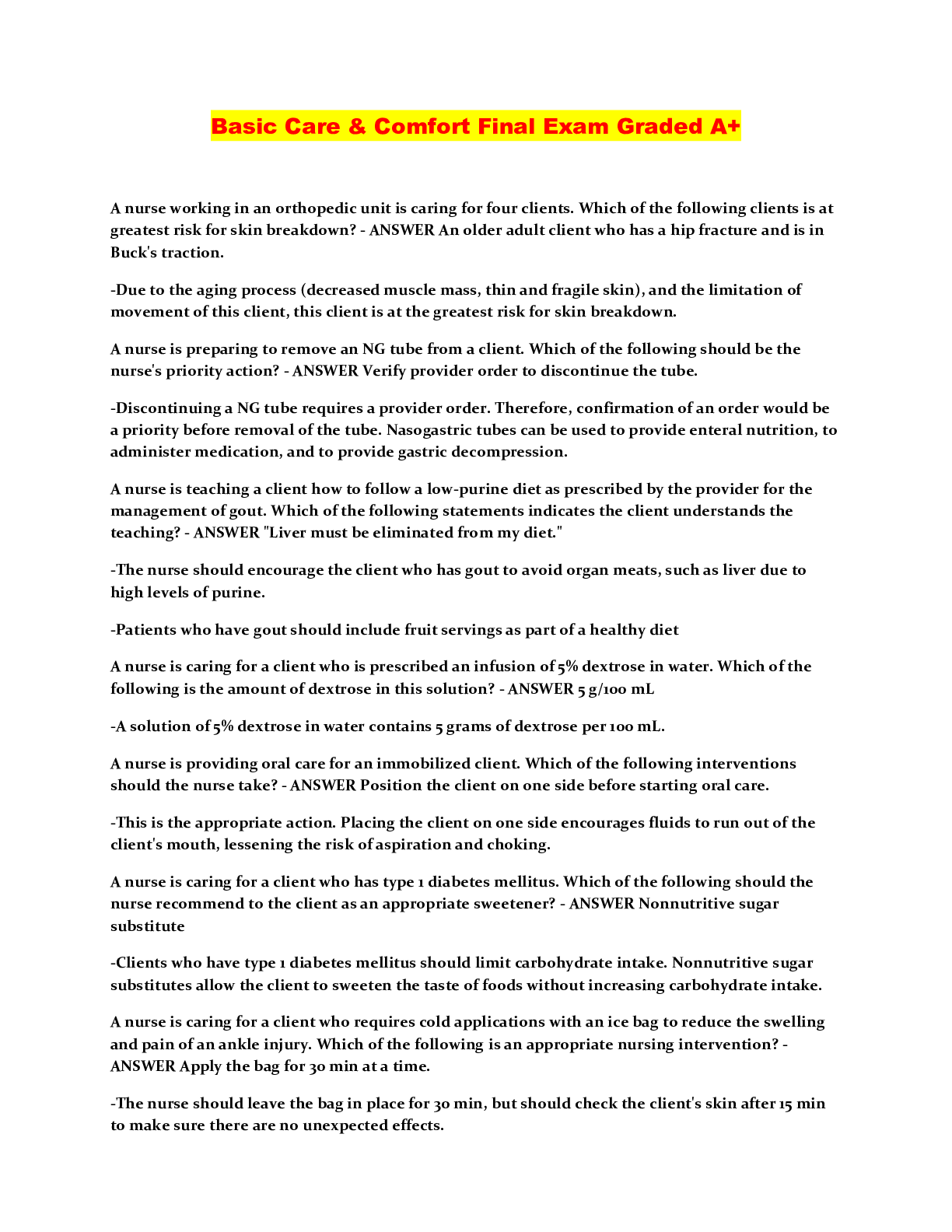*NURSING > QUESTIONS & ANSWERS > RASMUSSEN COLLEGE. NURSING 2407. NCLEX-RN: Physiological Integrity: Basic Care & Comfort Practice Qu (All)
RASMUSSEN COLLEGE. NURSING 2407. NCLEX-RN: Physiological Integrity: Basic Care & Comfort Practice Questions (ALL CORRECT ANSWERS
Document Content and Description Below
NCLEX-RN: Physiological Integrity: Basic Care & Comfort Practice Questions 1. As the registered nurse in the emergency department, you are taking care of an adolescent client who had just frac... tured their femur during gymnasium class at their high school. After casting, you will be discharging the client with crutches. Which of the following client goals that is paired with its learning domain should be included in the patient teaching plan for this client and the parents? A. Psychomotor domain: The client will slightly bend their elbows when holding the hand grips. B. Psychomotor domain: The client will rest their weight on the padded areas on the top of the crutches. C. Cognitive domain: The client will slightly bend their elbows when holding the hand grips. D. Cognitive domain: The nurse will tell the client how often the tips on the crutches must be replaced. 2. Which basic activity of daily living assistive device can be useful for the client who is a ected with poor ne motor coordination? A. An aphasia aid B. A button hook C. Honey thickened liquids D. A word board 3. As the nurse in an ambulatory care area, you see a new client enter with a cane that appears too short for the client. What should you do? A. Place the client in a wheelchair to protect their safety in the clinic. B. Remove the cane from the client to protect their safety. C. Teach the client about the proper length of a cane. D. Have the client use a wheelchair rather than the cane. 4. You are caring for a post-operative client who is complaining of abdominal distention and atus. Which intervention would you most likely do for this client? A. A cleansing enema B. A retention enema C. A return-Vow enema D. A laxative 5. Which of the following is a commonality that is shared in terms of both restraints and urinary catheters? A. Both can lead to infection. B. Both are invasive procedures. C. Both are considered sentinel. D. Both are the last resort. 6. Your incontinent client is incontinent of urine and stool. Which of the following products would you recommend for this client when cost is a major consideration in this decision? A. Any solid skin barrier B. A hydrocolloid solid skin barrier C. Hollister’s Flextend D. A skin sealant 7. You are planning discharge education for your client who has a new colostomy. Which complication of a colostomy should you educate this client about? A. A prolapsed stoma B. A vitamin B12 de ciency C. Nocturnal enuresis D. GI stone formation 8. Select the hazard of immobility that is accurately paired with an appropriate expected outcome of care that the nurse provides to prevent this complication. A. Bone demineralization: Turning and positioning every 2 hours B. Urinary stasis: The client will consume 1,000 mL of oral Kuids per day C. Muscle atrophy: The client will perform range of motion exercises at least 3 times a day D. Hypercalcemia: Maintaining uid intake of 1,000 mL per day 9. During you musculoskeletal assessment of the client, you determine that the client has muscular strength against gravity but not against resistance. You would document this assessment as: A. 1 on the scale of 1 to 3 B. 2 on the scale of 1 to 5 C. 3 on the scale of 0 to 5 D. 4 on the scale of 0 to 5 10. You are working as a wound care nurse. You measure the size of a client’s wound and it is 3 cm deep, 2 cm long and 4 cm wide. You would document the dimension of this wound as: A. 6SHAREScm B. 12 cm C. 20 cm D. 24 cm 11. Your client had a ruptured appendix and peritonitis. What type of healing would be most likely for this client? A. Secondary intention healing B. Tertiary intention healing C. Primary prevention healing D. Secondary prevention healing 12. You are caring for a client whose pressure ulcer is yellow. Which treatment will you most likely employ for this wound? A. A barrier lm B. An alginate dressing C. Surgical laser debridement D. Autolytic debridement 13. Which of the following theories of pain are you utilizing when you recognize the fact that some of the factors that open this “gate” to pain are low endorphins and anxiety and that some of the factors that close this “gate” to pain are decreased anxiety and fear? A. Moritz Schi\’s theory of pain B. The Intensive Theory of Pain C. Melzack and Wall’s theory of pain D. The Speci5city Theory of Pain 14. You routinely use the PQRST method to assess pain. The PQRST method consists of: A. Pain level, the quality of the pain, the region or area of the pain, the severity of the pain, and the pain triggers B. Precipitating factors, the quality of the pain, relief factors, the severity of the pain, and the pain triggers C. Pain level, the quantitative numerical pain score, the region or area of the pain, the severity of the pain, and the pain triggers D. Precipitating factors, the quality of the pain, the region or area of the pain, the severity of the pain, and the pain triggers 15. The A, B, C, and Ds of a complete and comprehensive nutritional assessment includes: A. Assessment data, biochemical data, clinical data and dietary data B. Ancestral cultural data, biochemical data, clinical data and dietary data C. Anthropometric data, biological data, chemical data and dietary data D. AnthropometricSHRES data, biochemical data, clinical data and dietary data 16. Your client has a tube feeding. Which of the following commonly occurring complications of tube feedings can you prevent with the preventive measure that is coupled with it? A. Constipation: The provision of a high ber diet B. Urinary pH changes: Encouraging ample oral Puid intake C. Aspiration: Maintaining the client in at least a 30 degree angle D. Aspiration: Maintaining the client in at least a 90 degree angle 17. Which of the following impacts on the client’s preferences in terms of hygiene routines and practices? A. Culture B. Locus of control C. Bodily surface area D. Diaphoresis 18. Select the age group that is accurately paired with the normal and recommended hours of sleep each day. A. The neonate: 10 to 15 hours a day B. The toddler: 11 to 14 hours a day C. The preschool child: 12 to 15 hours a day D. The school age child: Less than 8 hours a day [Show More]
Last updated: 1 year ago
Preview 1 out of 20 pages
Instant download

Buy this document to get the full access instantly
Instant Download Access after purchase
Add to cartInstant download
Reviews( 0 )
Document information
Connected school, study & course
About the document
Uploaded On
Apr 12, 2020
Number of pages
20
Written in
Additional information
This document has been written for:
Uploaded
Apr 12, 2020
Downloads
0
Views
61

















